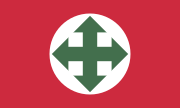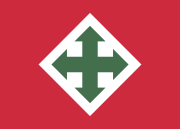
Back حزب الصليب المسهم Arabic حزب الصليب السهم ARZ Партия на кръстосаните стрели Bulgarian Creu Fletxada Catalan Strana Šípových křížů Czech Pilekorspartiet Danish Pfeilkreuzler German Sagokruca Partio Esperanto Partido de la Cruz Flechada Spanish Nuoliristi-puolue Finnish
Arrow Cross Party – Hungarist Movement Nyilaskeresztes Párt – Hungarista Mozgalom | |
|---|---|
 | |
| Leader | Ferenc Szálasi[1] |
| Founded | 15 March 1939 |
| Dissolved | 7 May 1945 |
| Preceded by | NSZMP – HM[2] |
| Headquarters | Andrássy út 60, Budapest |
| Membership | |
| Ideology | |
| Political position | Far-right[9] |
| Religion | Roman Catholicism |
| Political alliance | Hungarian National Socialist Party (until 1941)[10] |
| Colours | Red White Green |
| Anthem | "Ébredj Magyar!"[11] (lit. 'Wake up Hungarian!') |
| Most MPs in the Diet (1939) | 29 / 260 |
| Party flag | |
 | |
The Arrow Cross Party (Hungarian: Nyilaskeresztes Párt – Hungarista Mozgalom, lit. 'Arrow Cross Party – Hungarist Movement', abbreviated NYKP) was a far-right Hungarian ultranationalist party led by Ferenc Szálasi, which formed a government in Hungary they named the Government of National Unity. They were in power from 15 October 1944 to 28 March 1945. During its short rule, ten to fifteen thousand civilians were murdered outright, including many Jews and Romani,[12][13] and 80,000 people were deported from Hungary to concentration camps in Austria.[14] After the war, Szálasi and other Arrow Cross leaders were tried as war criminals by Hungarian courts.
- ^ Ferenc Szálasi. Retrieved from Encyclopædia Britannica.
- ^ Három hónapja nem fizetnek házbért az Andrássy úti nyilasok, 1938. augusztus, huszadikszazad.hu
- ^ "Ungváry Krisztián: A politikai erjedés – az 1939-es választások Magyarországon". Archived from the original on 2002-11-30. Retrieved 2007-03-14.
- ^ a b c d "Szálasi Ferenc: Hungarizmus (alapterv és követelések)". Archived from the original on 2007-09-28. Retrieved 2007-03-20.
- ^ PAYNE, Stanley: A History of Fascism, 1914-1945. 1995. p.272.
- ^ Weiss, John (1967). The Fascist Tradition: Radical right-wing extremism in modern Europe. New York, Evanston, and London: Harper & Row. pp. 88-89. ISBN 0060469951.
- ^ Mann, Michael (2004). Fascists. New York: Cambridge University Press. pp. 253-255. ISBN 0521538556.
- ^ Herczl, Moshe Y. (1993). Christianity and the Holocaust of Hungarian Jewry. NYU Press. pp. 67, 70, 233. ISBN 0814773206 – via Google Books.
A considerable portion of the media in Hungary described the swastika as a symbol of the forces defending European Christian culture, struggling bravely against the danger of Red expansion from the east and against the Bolshevik-Jewish Weltanschauung. It served as a source of inspiration for the various cross movements, including the Arrow-Cross party.
- ^ Moshe Y. Herczl (1993). Christianity and the Holocaust of Hungarian Jewry. NYU Press. pp. 67, 70, 233. ISBN 0814773206 – via Google Books.
- ^ Stanley G. Payne (2001). A History of Fascism 1914-1945. London, Routledge. pp. 273-274, 415-416.
- ^ "Ébredj Magyar - Hungarista Induló". YouTube. 2021-01-10. Retrieved 2024-02-03.
- ^ Patai, Raphael (1996). The Jews of Hungary: History, Culture, Psychology. 590: Wayne State University Press. p. 730. ISBN 0-8143-2561-0.
{{cite book}}: CS1 maint: location (link) - ^ Historical Dictionary of the Holocaust, Jack R. Fischel, Scarecrow Press, 17 Jul 2010, pg106
- ^ Johnston, Chris (2006-02-16). "War Crime Suspect Admits to his Leading Fascist Role". The Age. Archived from the original on 17 May 2009. Retrieved 2009-04-19.
Cite error: There are <ref group=n> tags on this page, but the references will not show without a {{reflist|group=n}} template (see the help page).
© MMXXIII Rich X Search. We shall prevail. All rights reserved. Rich X Search

